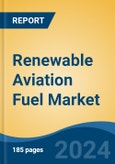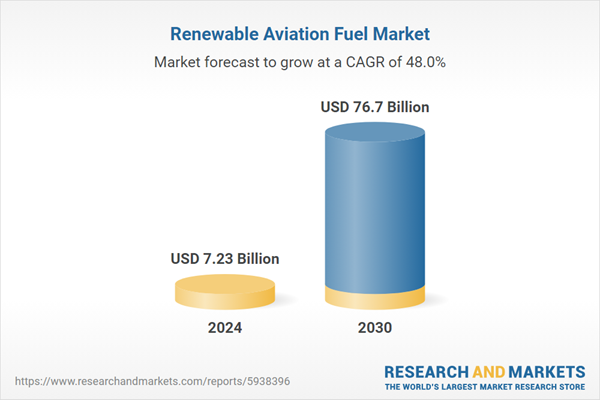Speak directly to the analyst to clarify any post sales queries you may have.
10% Free customizationThis report comes with 10% free customization, enabling you to add data that meets your specific business needs.
Since the count of Renewable Aviation Fuel providers (suppliers) is less in comparison to the count of buyers, the bargaining power of suppliers is relatively higher as compared to the bargaining power of buyers. Due to promising profit margins, the threat of new entrants in the Renewable Aviation Fuel market is considered to be moderate.
Key Market Drivers
Rising Air Travel
The Renewable Aviation Fuel market is majorly driven by the rising trend of air travel and the expanding aviation sector in various developing nations. As global air traffic continues to recover and expand, the aviation industry is under pressure to reduce its carbon footprint and meet stricter environmental regulations. Renewable Aviation Fuels, such as biofuels and synthetic fuels made from sustainable resources, offer a promising solution to mitigate the environmental impact of air travel. With governments and aviation bodies setting ambitious targets for reducing carbon emissions, airlines are turning to RAFs to comply with sustainability goals and ensure their operations align with global efforts to combat climate change.As air travel demand rises, the pressure on traditional aviation fuels, which contribute significantly to global carbon emissions, also grows. This has led to increased investments in developing and scaling up renewable aviation fuel technologies. RAFs can significantly lower lifecycle carbon emissions compared to conventional jet fuels, offering a more sustainable alternative. Additionally, as airlines look to diversify their fuel sources to ensure energy security and reduce reliance on fossil fuels, the adoption of RAFs is becoming essential for the future of the aviation sector. The increasing push from both industry and regulatory bodies for more eco-friendly solutions is expected to drive the rapid expansion of the RAF market in the coming years.
Key Market Challenges
Volatility in Crude Oil Prices:
One of the primary challenges faced by the Renewable Aviation Fuel market is the inherent volatility in crude oil prices. The aviation industry is heavily dependent on crude oil for jet fuel production, and fluctuations in oil prices can significantly impact operational costs for airlines. Political instability, geopolitical tensions, and economic uncertainties contribute to this volatility, making it a perpetual concern for the Renewable Aviation Fuel market.Key Market Trends
Transition to Sustainable Renewable Aviation Fuels (SAFs):
One of the most prominent trends in the Renewable Aviation Fuel market is the increasing emphasis on sustainability. As environmental concerns rise, there is a growing shift towards Sustainable Renewable Aviation Fuels (SAFs). These fuels, derived from renewable resources such as biofuels and synthetic fuels, aim to reduce the carbon footprint of aviation. Governments, airlines, and fuel producers are investing in research and development to enhance the production and adoption of SAFs, marking a crucial step towards a more environmentally friendly aviation industry.Key Market Players
- TotalEnergies SE
- Neste Oyj
- Swedish Biofuels AB
- Red Rock Biofuels LLC
- Gevo Inc.
- Honeywell International Inc.
- Fulcrum BioEnergy Inc.
- Preston Corporation Pte Ltd.
- LanzaTech Inc.
- Shell plc
Report Scope:
In this report, the Global Renewable Aviation Fuel Market has been segmented into the following categories, in addition to the industry trends which have also been detailed below:Renewable Aviation Fuel Market, By Fuel Technology:
- Fischer-Tropsch (FT)
- Hydroprocessed Esters and Fatty Acids (HEFA)
- Synthesized Iso-Paraffinic (SIP)
- Alcohol-to-Jet (AtJ)
Renewable Aviation Fuel Market, By End User:
- Commercial
- Defense
- General Aviation
Renewable Aviation Fuel Market, By Region:
- North America
- United States
- Canada
- Mexico
- Asia-Pacific
- China
- India
- Japan
- South Korea
- Indonesia
- Europe
- Germany
- United Kingdom
- France
- Russia
- Spain
- South America
- Brazil
- Argentina
- Middle East & Africa
- Saudi Arabia
- South Africa
- Egypt
- UAE
- Israel
Competitive Landscape
Company Profiles: Detailed analysis of the major companies present in the Global Renewable Aviation Fuel Market.Available Customizations:
With the given market data, the publisher offers customizations according to a company's specific needs. The following customization options are available for the report.Company Information
- Detailed analysis and profiling of additional market players (up to five).
This product will be delivered within 1-3 business days.
Table of Contents
Companies Mentioned
- TotalEnergies SE
- Neste Oyj
- Swedish Biofuels AB
- Red Rock Biofuels LLC
- Gevo Inc.
- Honeywell International Inc.
- Fulcrum BioEnergy Inc.
- Preston Corporation Pte Ltd.
- LanzaTech Inc.
- Shell plc
Table Information
| Report Attribute | Details |
|---|---|
| No. of Pages | 188 |
| Published | March 2025 |
| Forecast Period | 2024 - 2030 |
| Estimated Market Value ( USD | $ 7.23 Billion |
| Forecasted Market Value ( USD | $ 76.7 Billion |
| Compound Annual Growth Rate | 48.0% |
| Regions Covered | Global |
| No. of Companies Mentioned | 10 |









